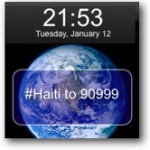
Ushahidi, which was named a “Game Changer” at last year’s conference, is utilizing digital mapmaking technology and social media to map and verify vital information in Haiti. Ushahidi plots key information on a Google map of Haiti: makeshift hospitals, locations of survivors and people still trapped and reports of unstable bridges. The map helps rescue workers locate and track of survivors, as well navigate the dangerous landscape of destruction.
The Extraordinaries, one of two winners at the Pitch It! Competition at last year’s conference, applies facial-recognition technology to finding missing people in Haiti. Since we first posted about them last week, our friends at The Extraordinaries have worked around the clock with the State Department on a coordinated technology effort to support relief efforts in Haiti. From its Earthquake Support Center, accessible by computer and the mobile Internet, The Extraordinaries’ facial recognition technology enables relief workers and family members to match faces of missing persons to images from news reports across the Internet.
“We’ve had over 31,000 image tags submitted by thousands of people, in three days,” founder Jacob Colker told us. “ We’ve also had over 640 searches queried by families looking for missing loved ones. NBC, ABC, CNN have all run stories about our efforts.” Watch the videos.
The project has also spawned a stream of information from users in the Extraordinaries growing social network of volunteers.
From a situation room at Tufts University, ten Ushahidi volunteers are working 24/7 finding, evaluating and posting relevant information on digital maps. The maps are categorized for emergencies, threats, logistics, and missing people.
Information submitted to the site via outside users are checked by the volunteers to ensure legitimacy (posts designate whether information is verified on unverified). Patrick Meier, Ushahidi’s humanitarian response and crisis mapping specialist, told the MIT Technology Review that the process could be automated in the future by the group’s Swift River platform, a predictive tagging, program that will try to cross-validate crowd-sourced information by comparing reports from texts, Twitter, news feeds, YouTube and other sources.
Like The Extraordinaries, Ushahidi has set up as social network, Crisis Mappers Net, which has become a communications channel for state departments, NGOs, and people in the technology and public health sectors. Ushahidi is also collaborating with Instedd’s GeoChat, another map-based communications platform working with the Emergency Information Services (EIS).